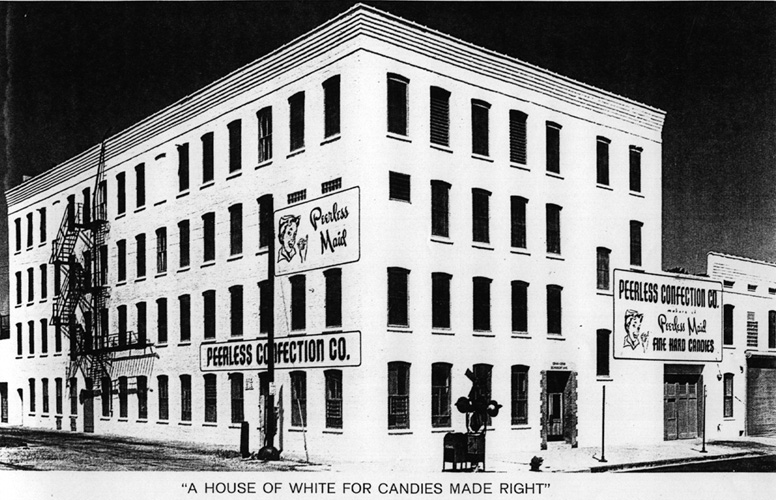Standing next to the train is Richard Sanders, conductor. As the trucks begin to clear the tracks, Sanders, using a two-way radio, tells Crocetti to move forward again. "Just a little further, Pete. About half a car length," Sanders says into the radio. "That's good." He flips a switch in the street, and the train reverses directions. Wheels screeching, it heads north toward Peerless Confection Co. at Lakewood Avenue and Diversey Parkway - the end of the line for Lincoln Park's "Sugar Train".

Photo courtesy of Peerless Confection Company
The approach to the factory, surrounded by single family homes and new townhouses, is different than for the typical industrial customers served by the train. "Peerless is unbelievable," Crocetti says. "You ride down the middle of streets, in the back of people's yards, through parking lots. It's pretty unique - not too many railroads do that anymore."
Every Tuesday and Thursday at about 9am, the pair leave a Bensenville railyard with about 15 freight cars. On a recent Thursday, they're riding a 1750-horsepower GP9. In 39 years of service, the locomotive probably logged 4 to 5 million miles, some of it with SOO LINE's long-defunct passenger operations, Crocetti said. The train runs up to 45 mph for much of the route, but when it approaches the North Branch of the Chicago River on the Bloomingdale Line the rails are so old and fragile that Crocetti slows to a modest 8 mph to avoid the risk of derailing.
After making a few stops at industries along the North Branch of the Chicago River, including Akzo Salt, A. Finkl & Sons, and Sipi Metals Corp., the train heads north toward Peerless. It crosses Armitage Avenue, turns off of Kingsbury and prepares to cross Clybourn Avenue which, like Armitage, has no crossing gates. Sanders, standing on the front of the engine, waits for a lull in the traffic, then tells Crocettito hit it. Blasting the horn, the train rumbles across the street and heads into the Treasure Island grocery store's parking lot, 2121 N. Clybourn Avenue. Housewives driving small Japanese imports clear the tracks while a woman waves from the porch of a nearby townhouse. After removing two temporary barricades and opening a locked gate, the train crosses Webster Avenue.
At the Lakeshore Athletic Club, 1320 W. Fullerton Ave. the parking lot looks wide open. Some days cars parked on the tracks have to be towed, but today it's clear. Next to the track is a busload of grinning school kids, many waving their arms out the windows in a wild pumping motion. Crocetti complies and blows the horn to the shriek of the children. Past the athletic club, Sanders unlocks another gate before the train moves onto Lakewood. Crocetti blowing the horn forges ahead. Sanders, again on foot, removes several "men working" signs from the track while a patron from the Schubert Inn steps into the doorway to watch the train roll past.
Finally, five hours after it left Bensenville, the crew has Peerless in view. In order to place the cars alongside the factory, the train has to pull up to Diversey, then back the cars into their spot. It's a tough maneuver because at Diversey, the tracks on Lakewood disappear under a bed of asphalt. Crocetti, undaunted, moves the engine a few feet into Diversey, its weight crushing the asphalt. With eastbound traffic at a standstill, a policeman arrives to investigate.
"Hey you," the policeman says to Sanders, who is talking to Crocetti on the radio.
"You got to go a little more, Pete," Sanders says.
"Hey buddy, I'm talking to you."
"A little more." Sanders says again.
"Don't walk away from me."
A minute later Sanders is in the back of a squad car. Crocetti leaves the cab to intervene, and heated words are exchanged. But before long, the romance of the rails takes over and everyone is smiling again. Sanders is released from the back seat of the car and Crocetti climbs back to his seat in the locomotive. "These people, they don't understand we're working out here," Sanders says and guides the cars to their spot.
Written by: PETER L. STRAZZ
***** ***** ***** ***** ***** *****
For more background on this fascinating operation, refer to the following:
"Soo's Street Switcher"; Mike Abalos;
Pacific Rail News, November 1990.
"Soo's Street Switcher"(part II),; Mike
Abolos; Pacific Rail News, February 1991.
"Freight on the 'L'"; Walter Weart;
Railfan & Railroad, February 1988.
"Chicago's Candy Line[focus on northern
segment to Peerless]"; Tom Burke; Rail Classics, January 1988.
"Evanston via Chicago, Milwaukee & St.
Paul"; James Buckley,et.al; The Milwaukee Railroader, June 1984.
"Milwaukee Road Knocking at Chicago's
Back Door"; Tom Burke; The Milwaukee
Railroader, Third Quarter 1995.
"Milwaukee Road's Kingsbury Branch";
Randall M. Willis; Model Railroader, April 1975.
"The N scale Kingsbury Branch"; Bill
Denton; Model Railroader, January 1997.